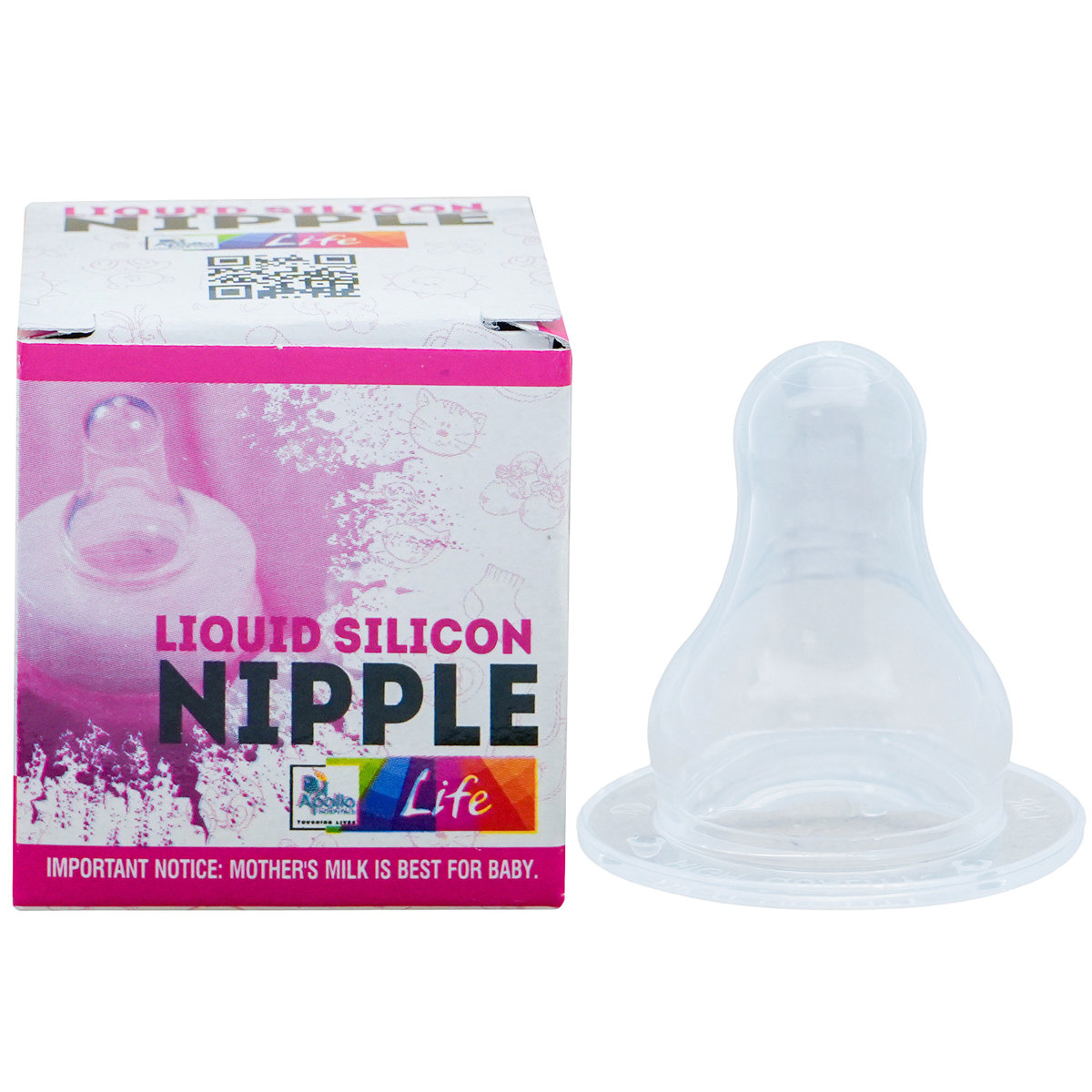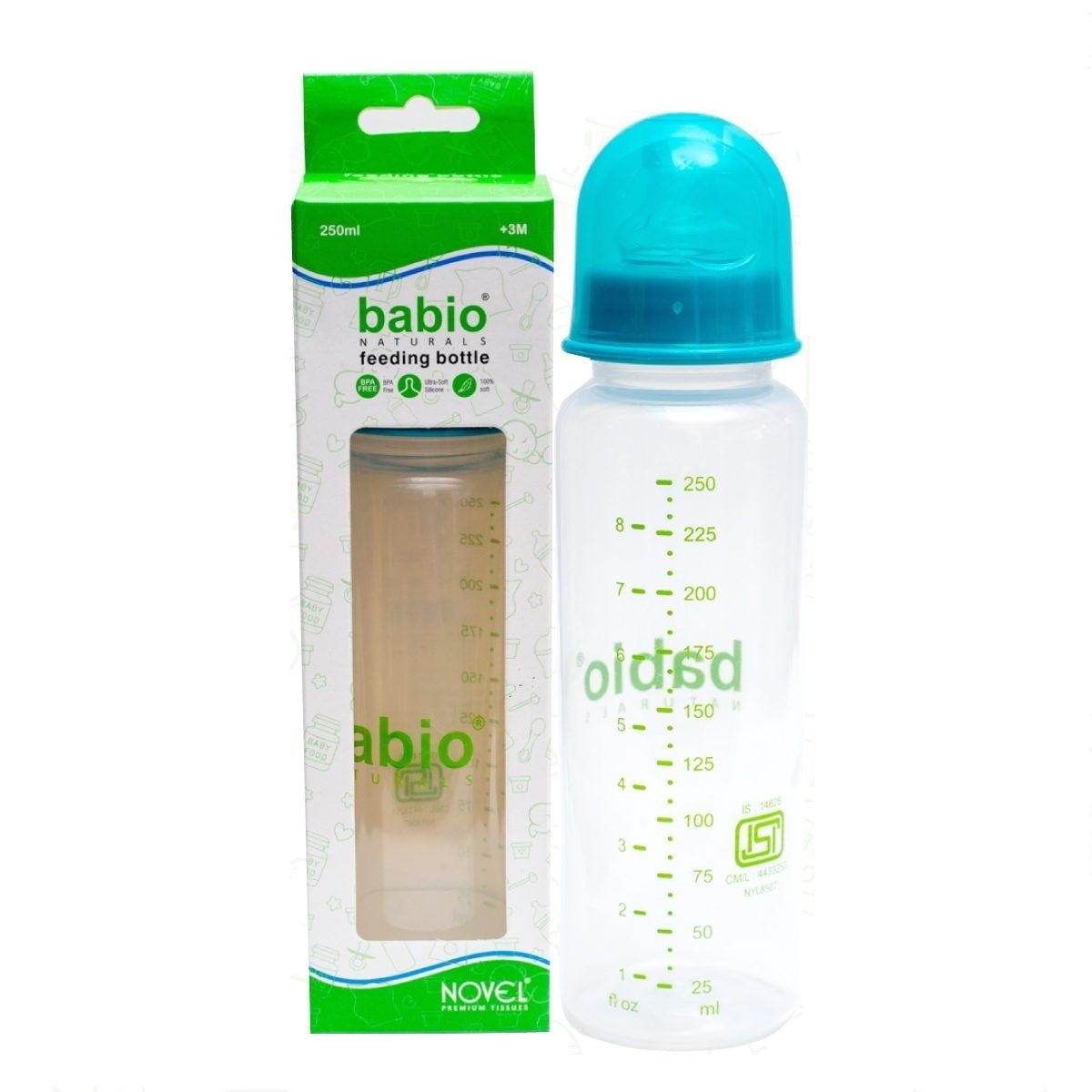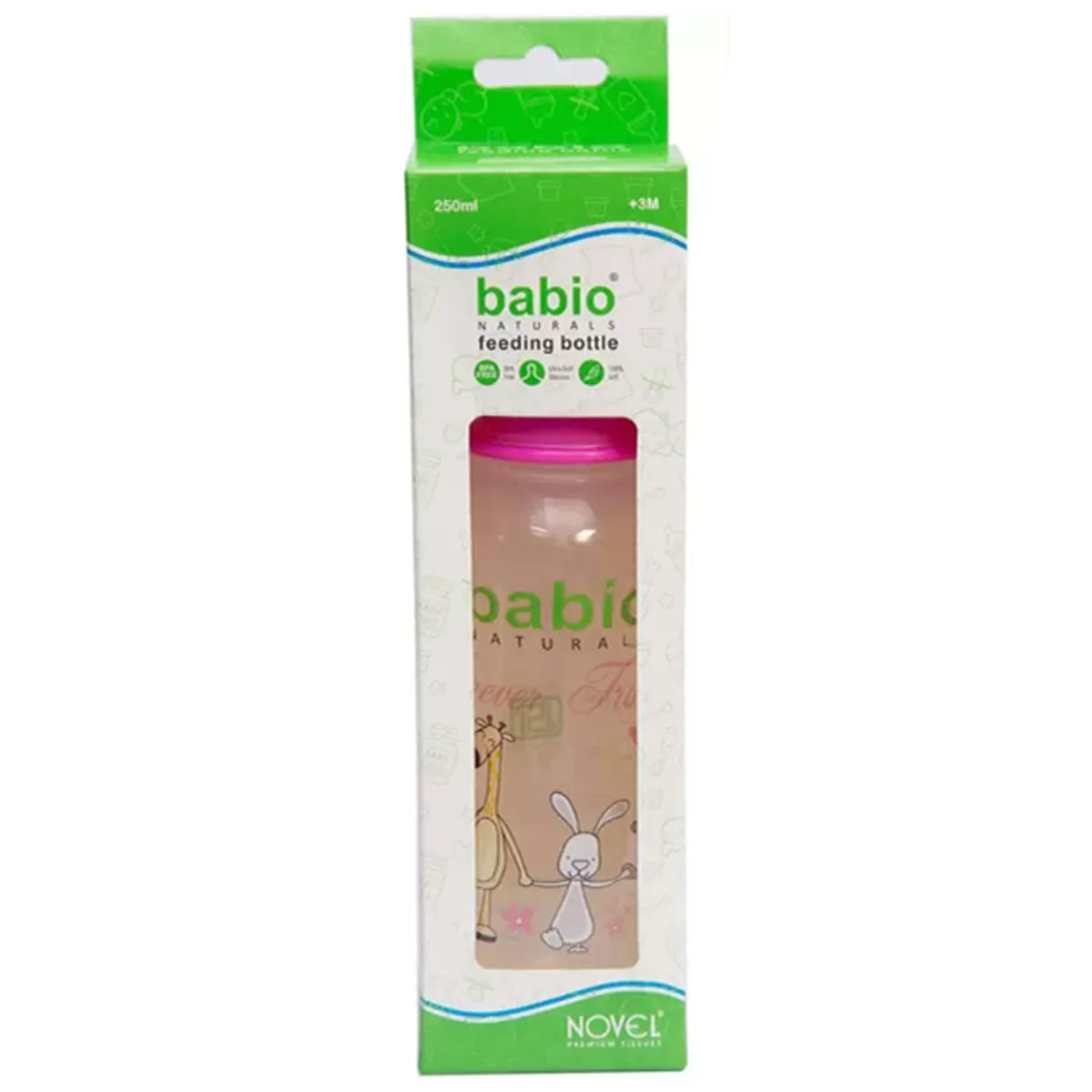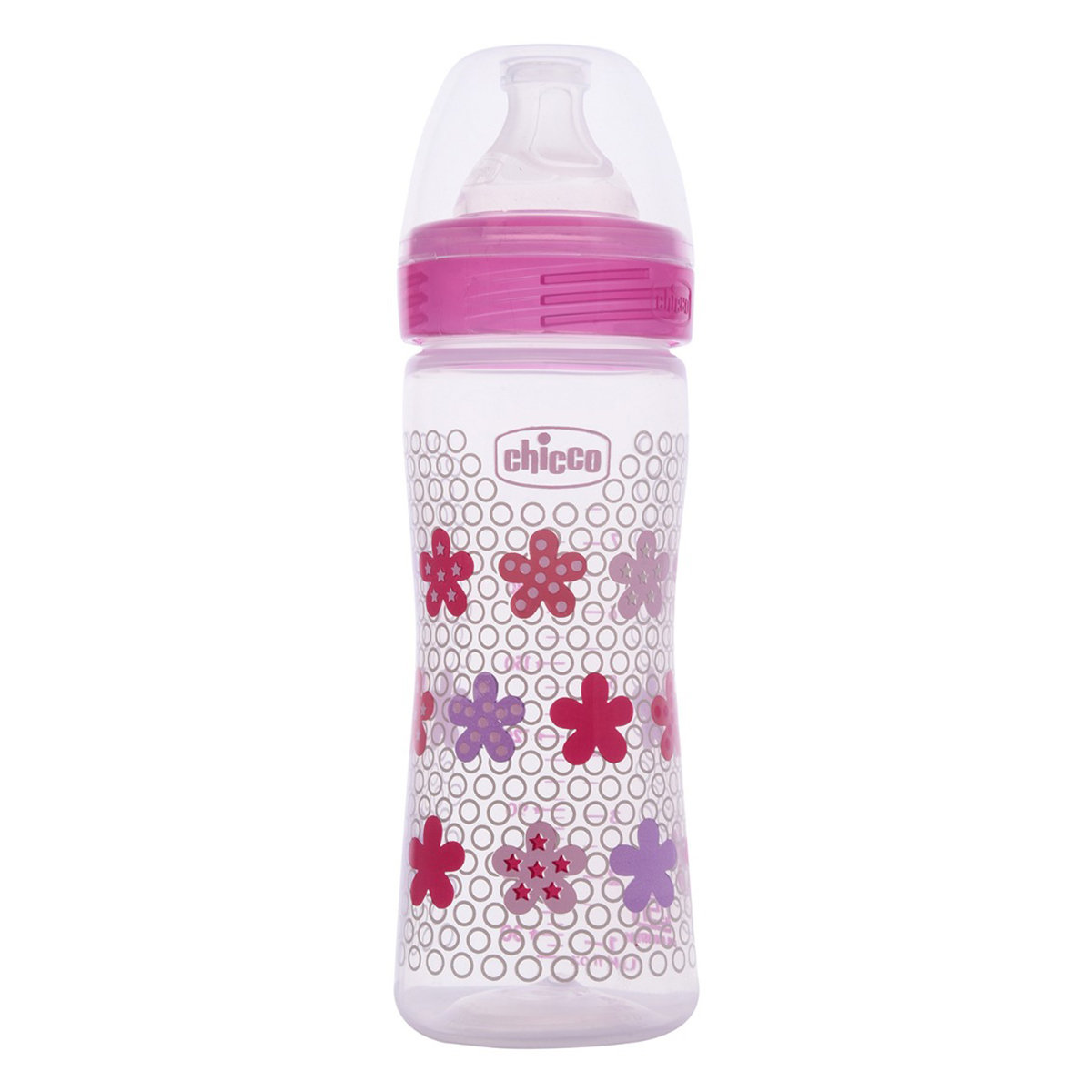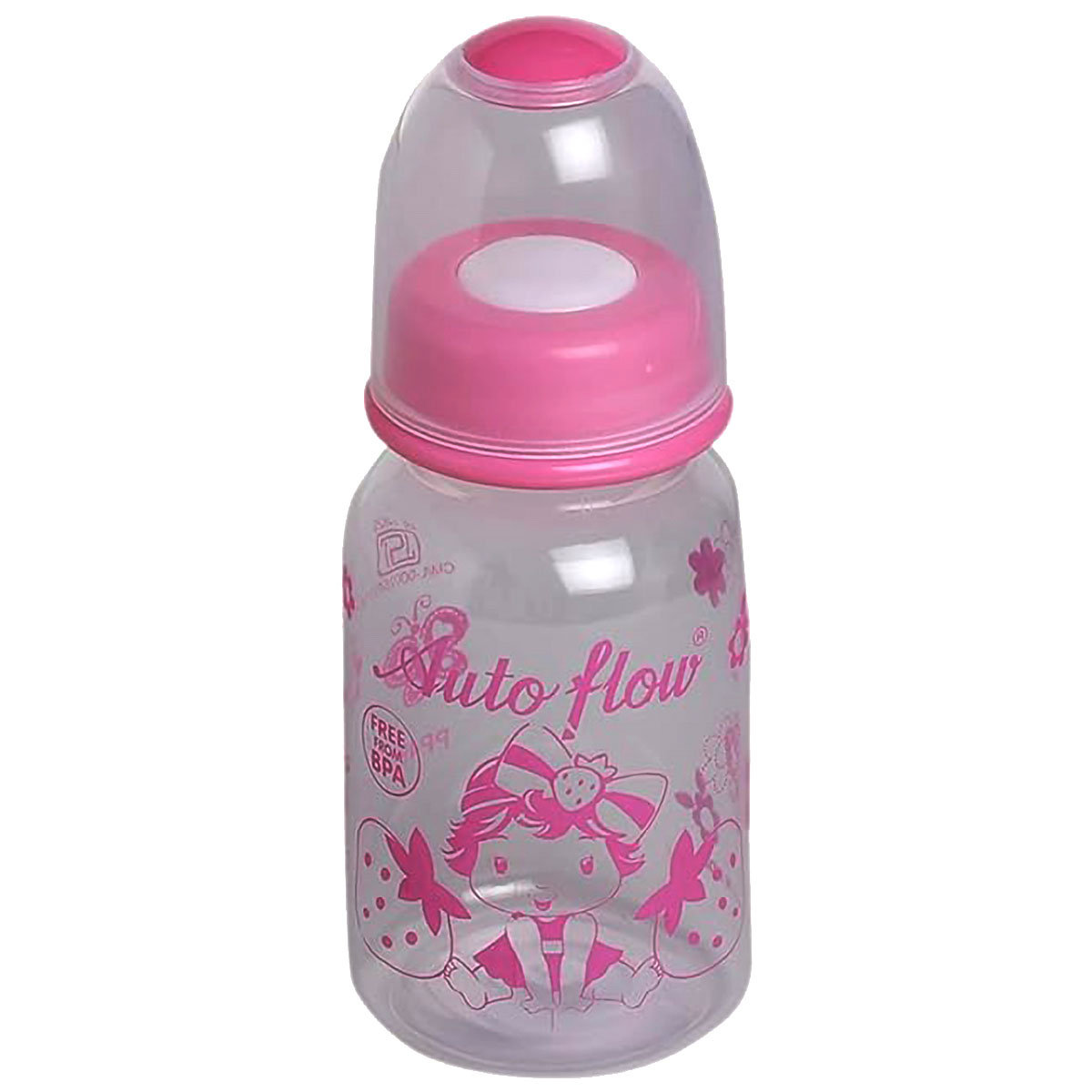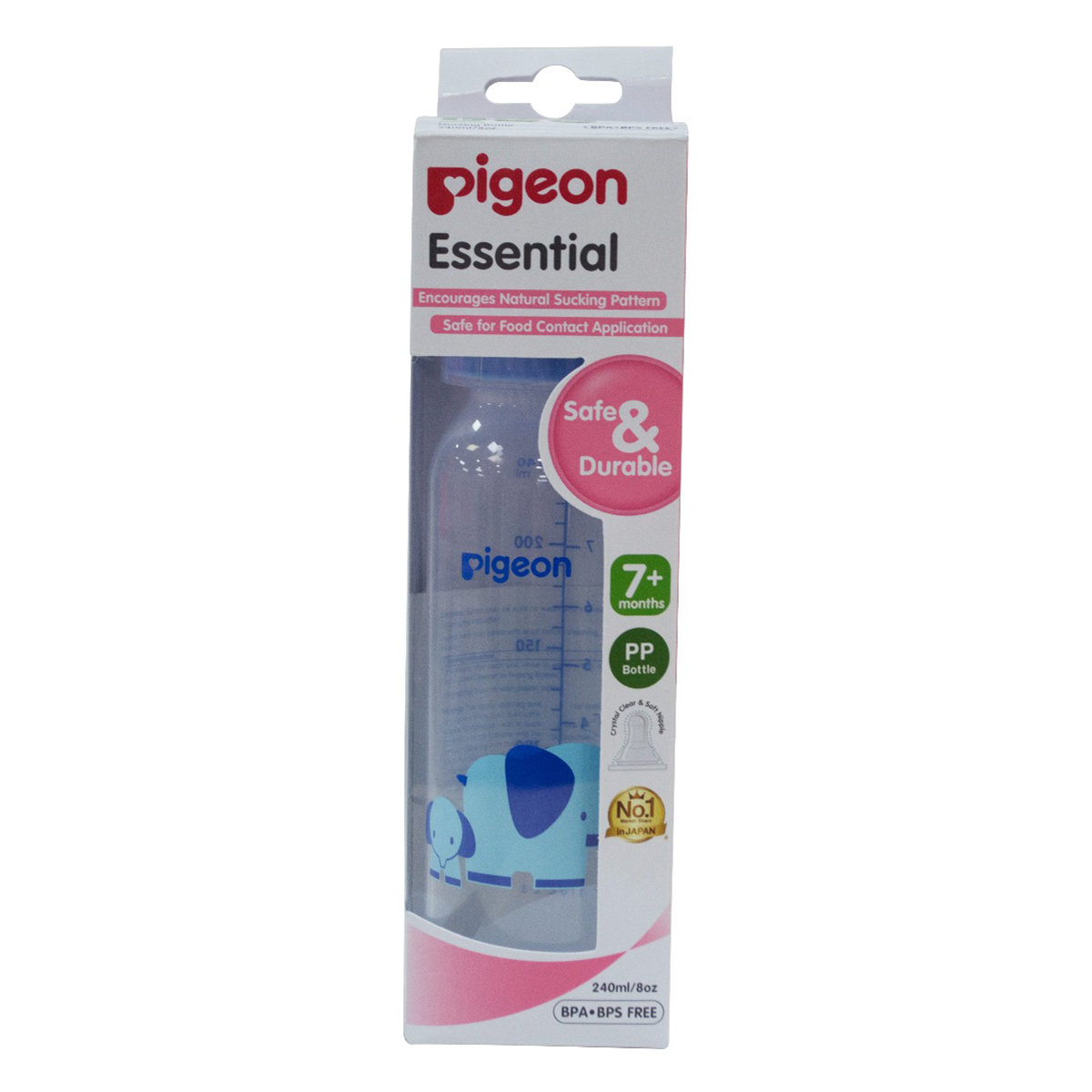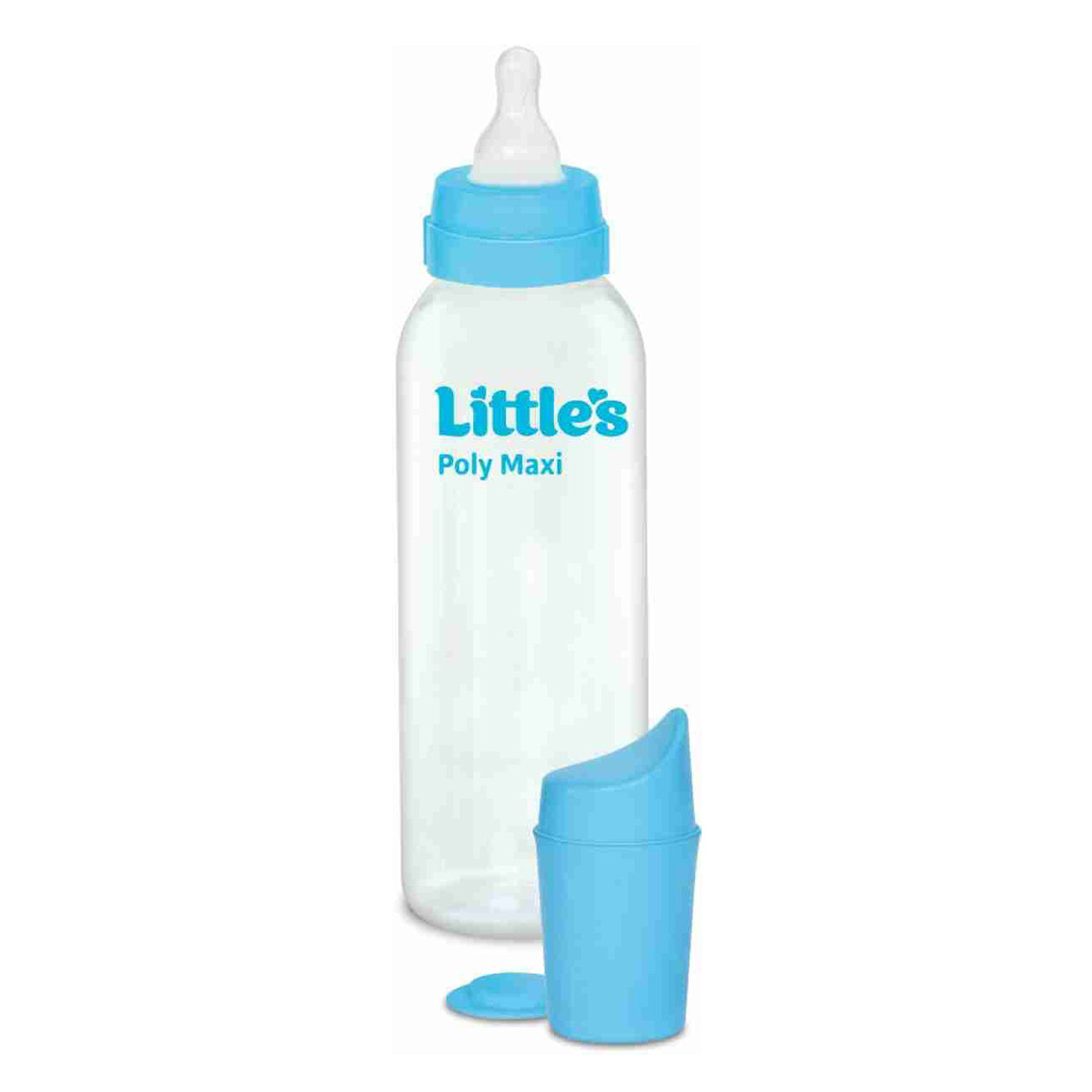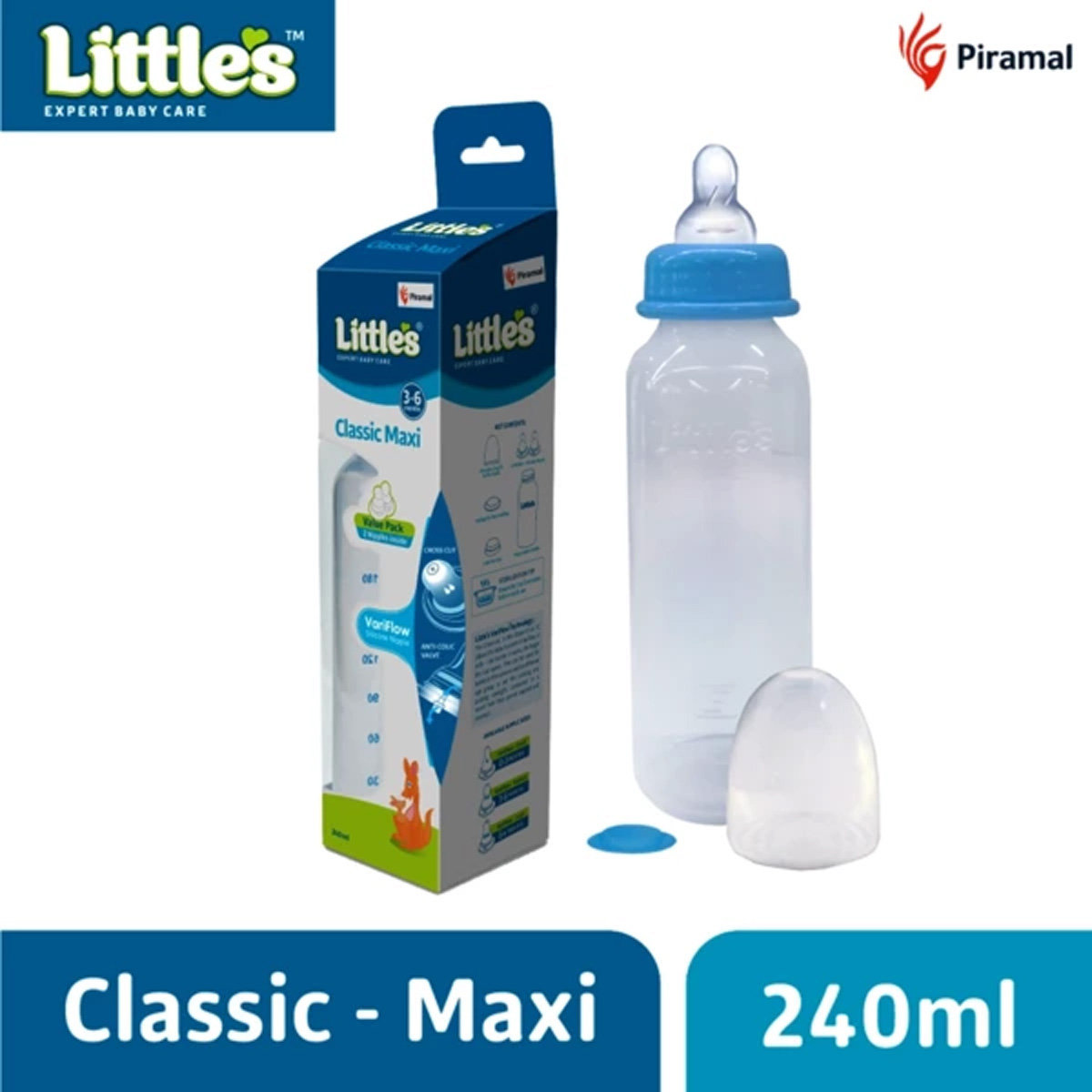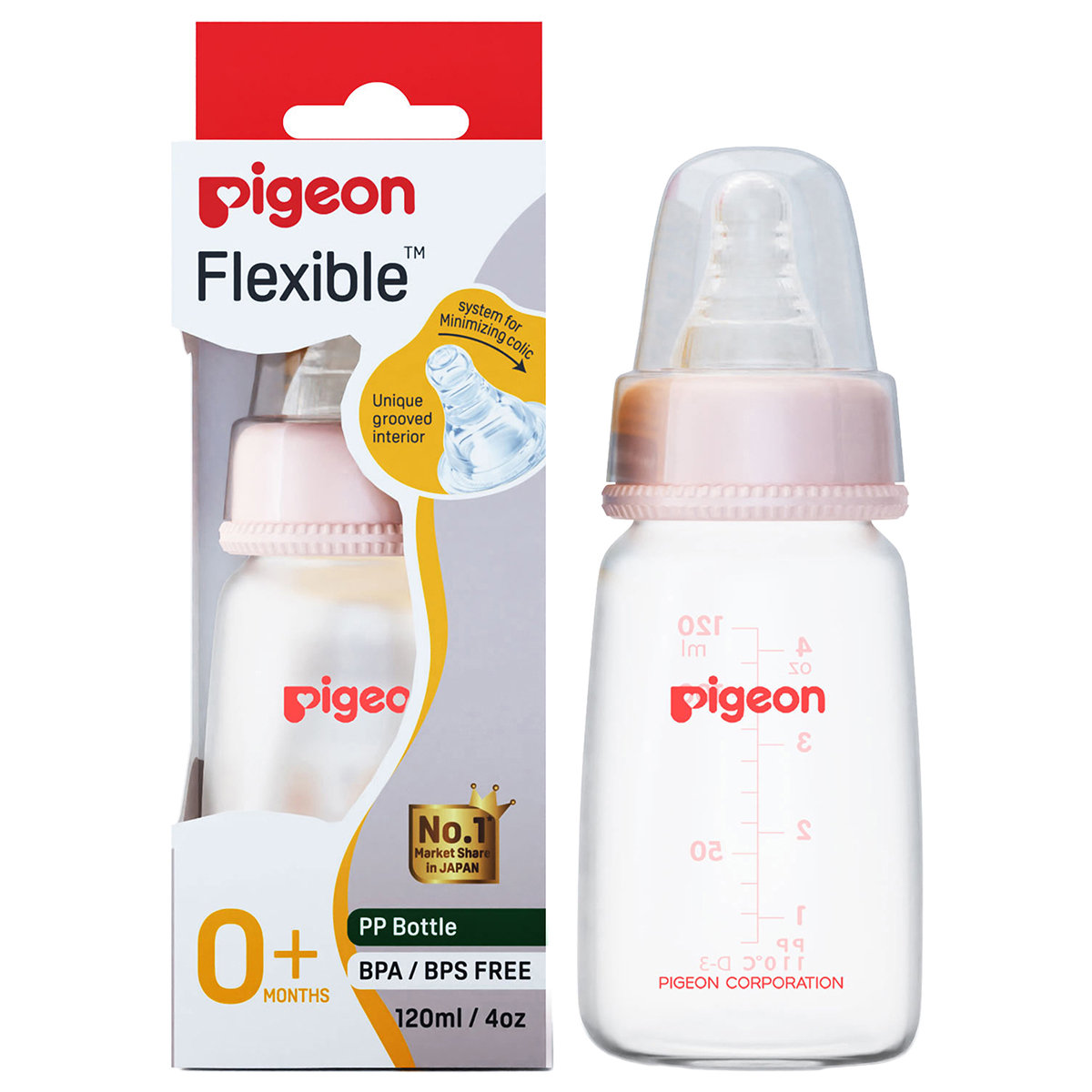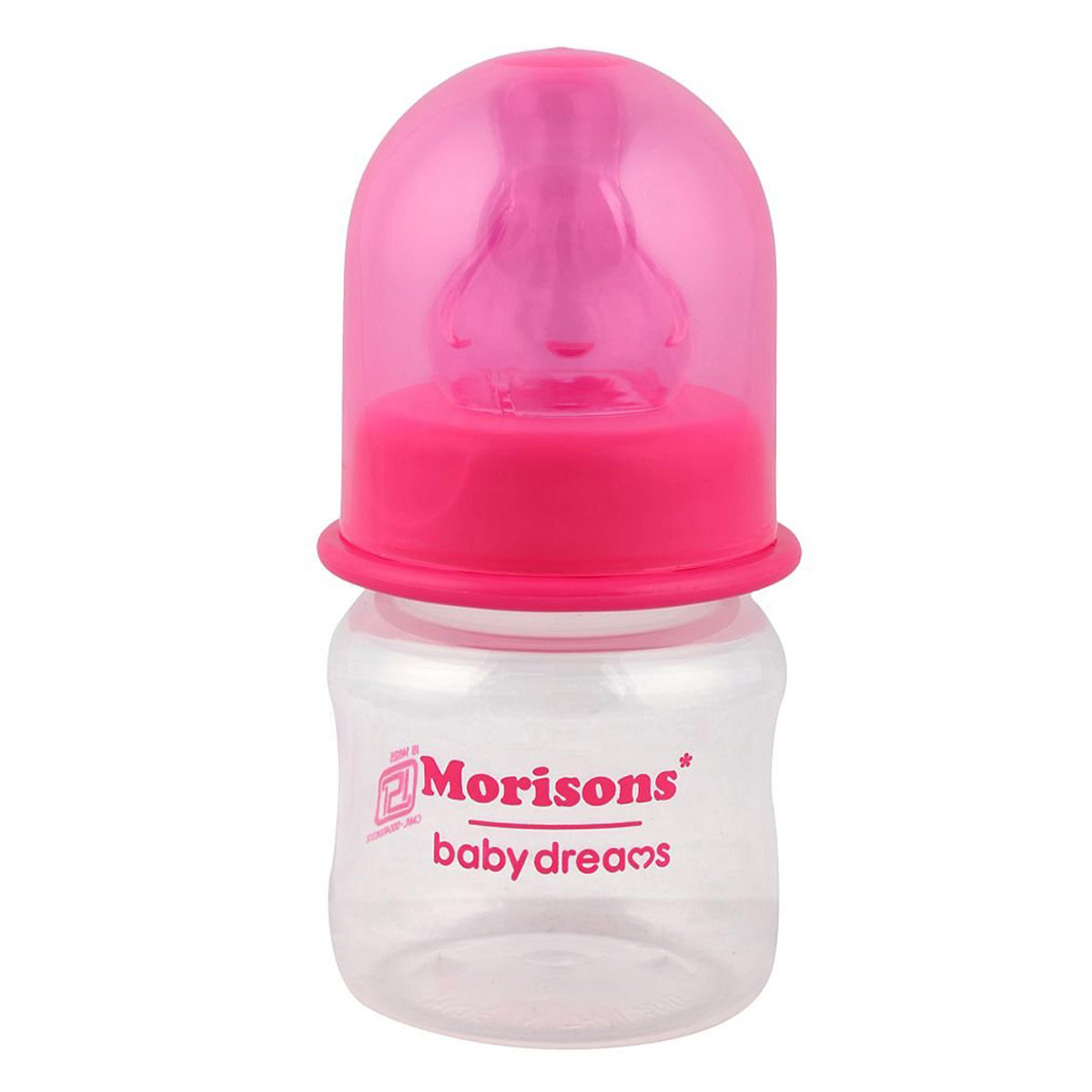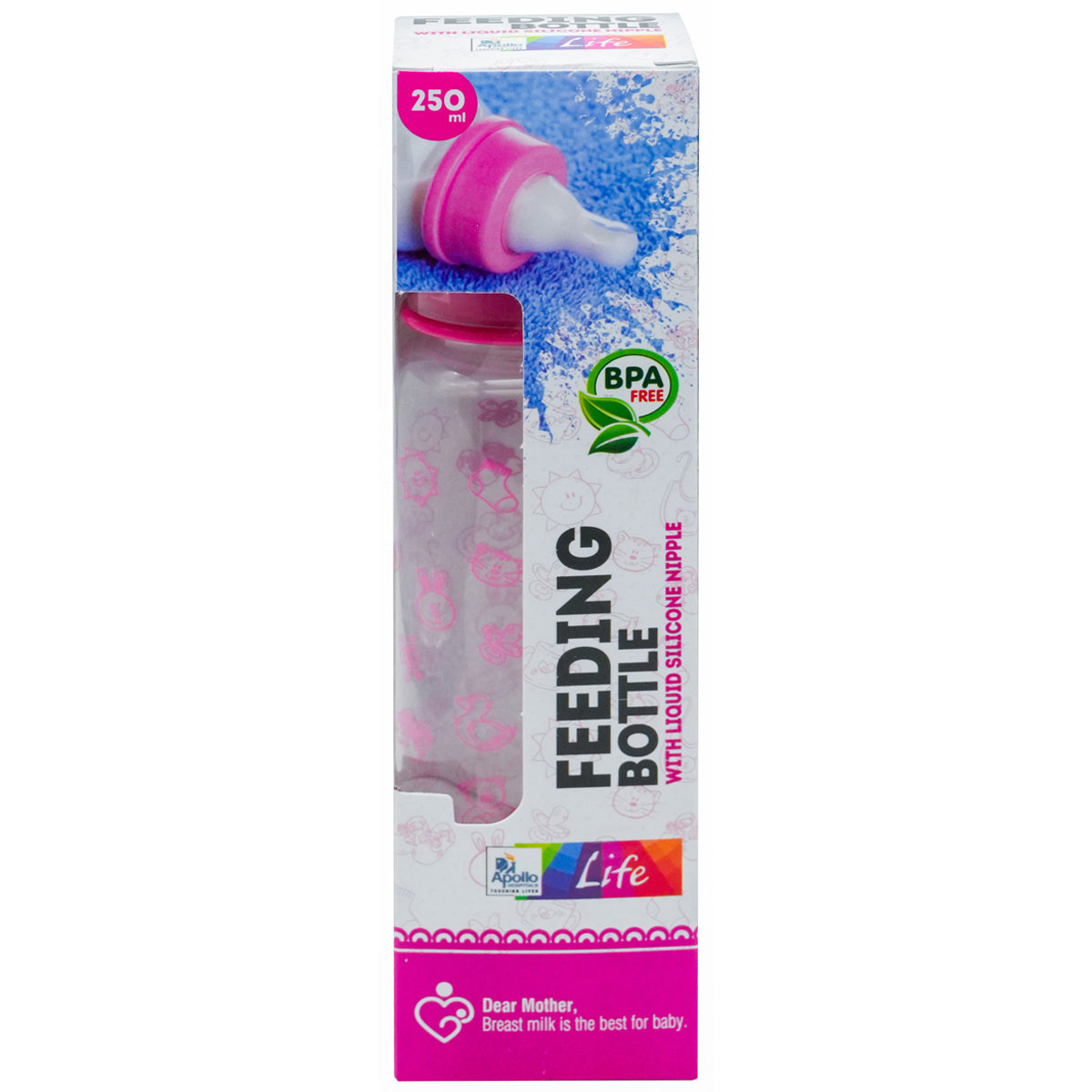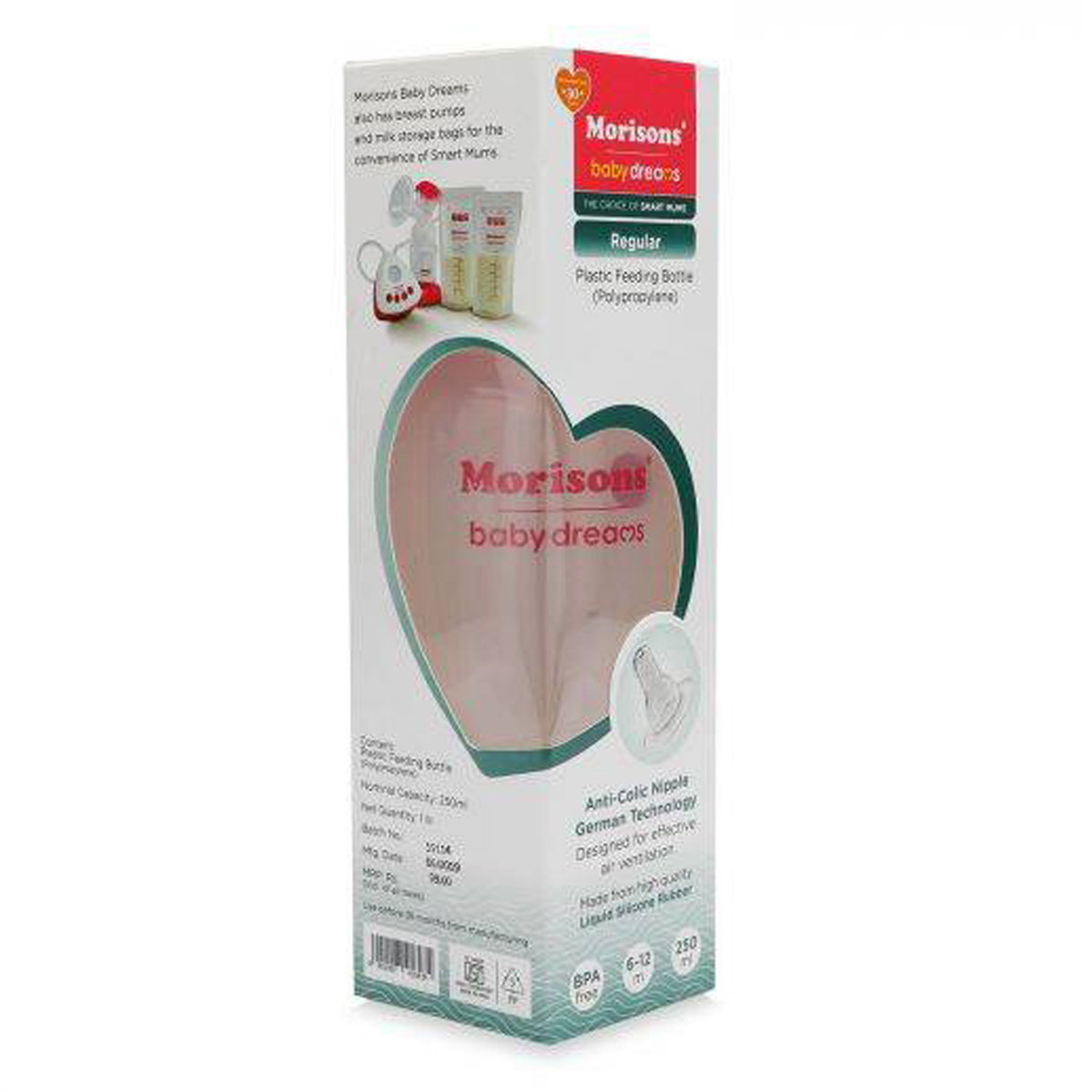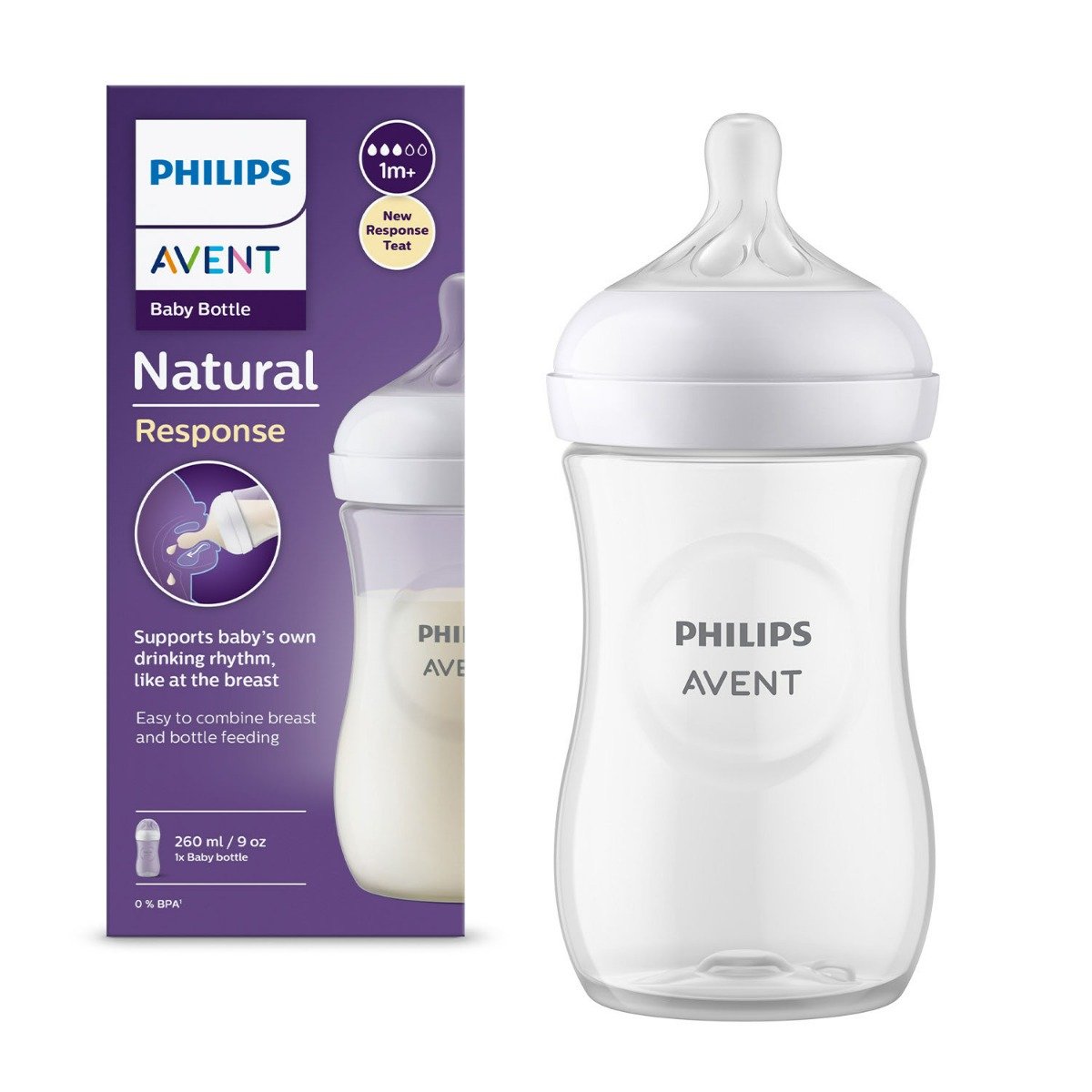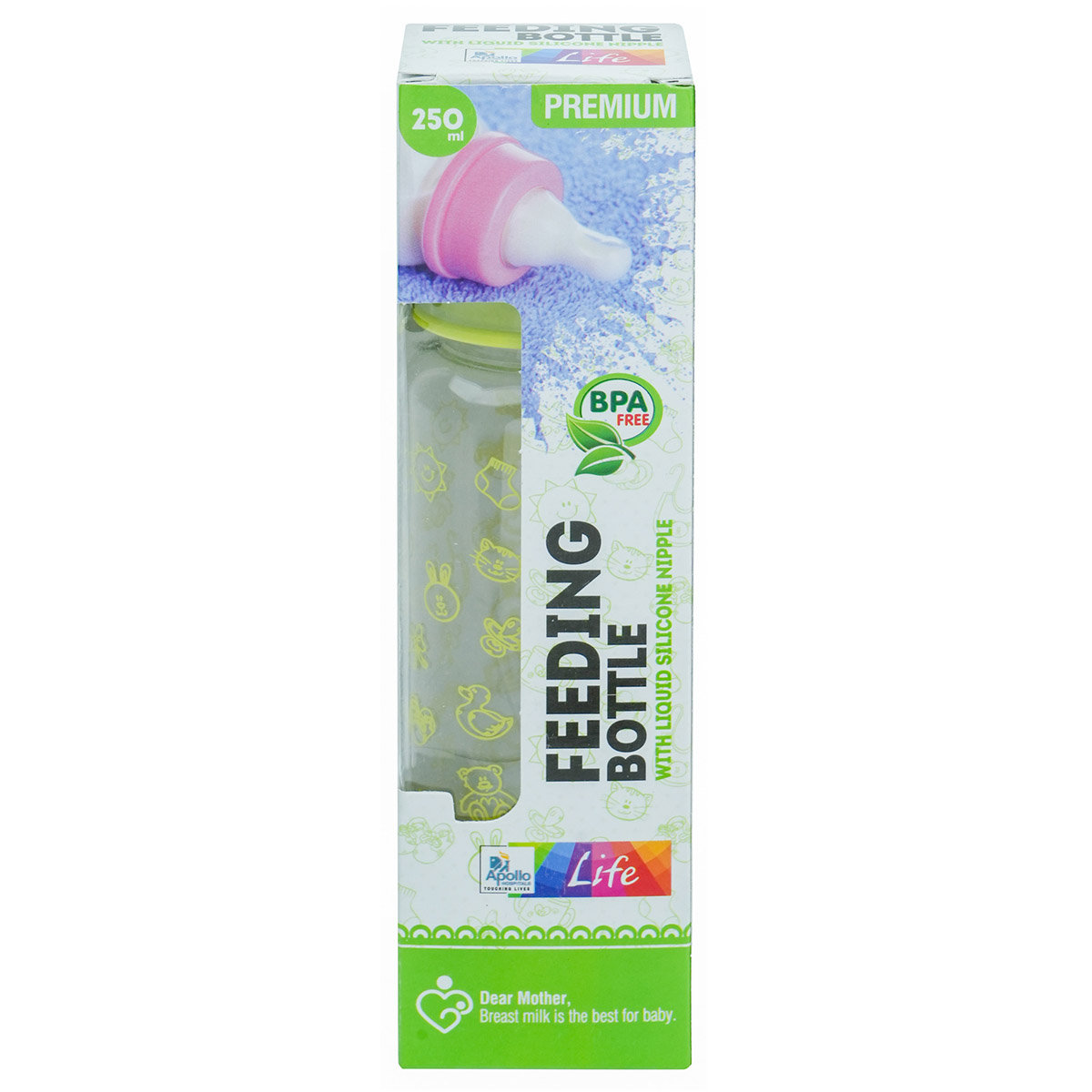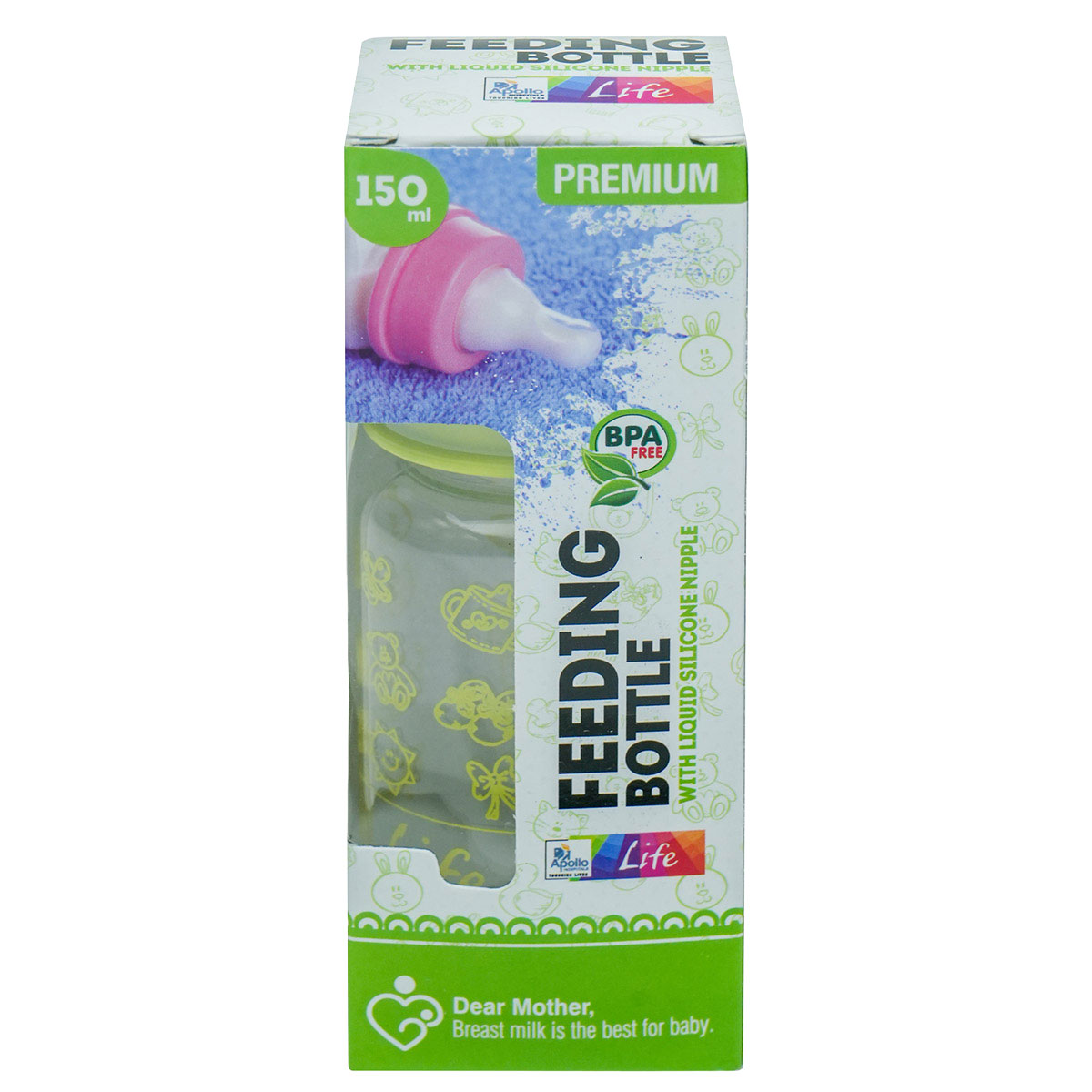Pigeon Essential Bee Feeding Bottle, 240 ml
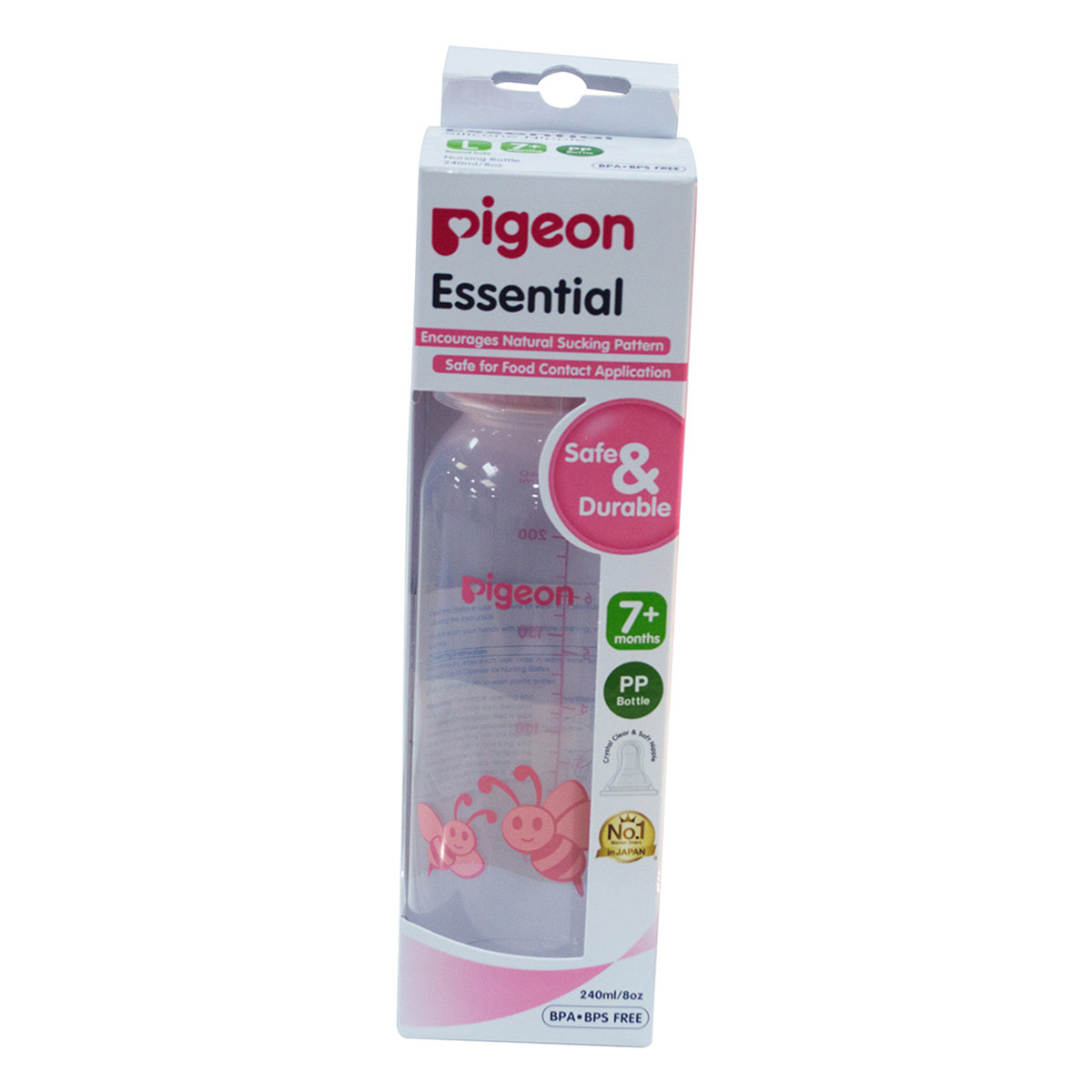
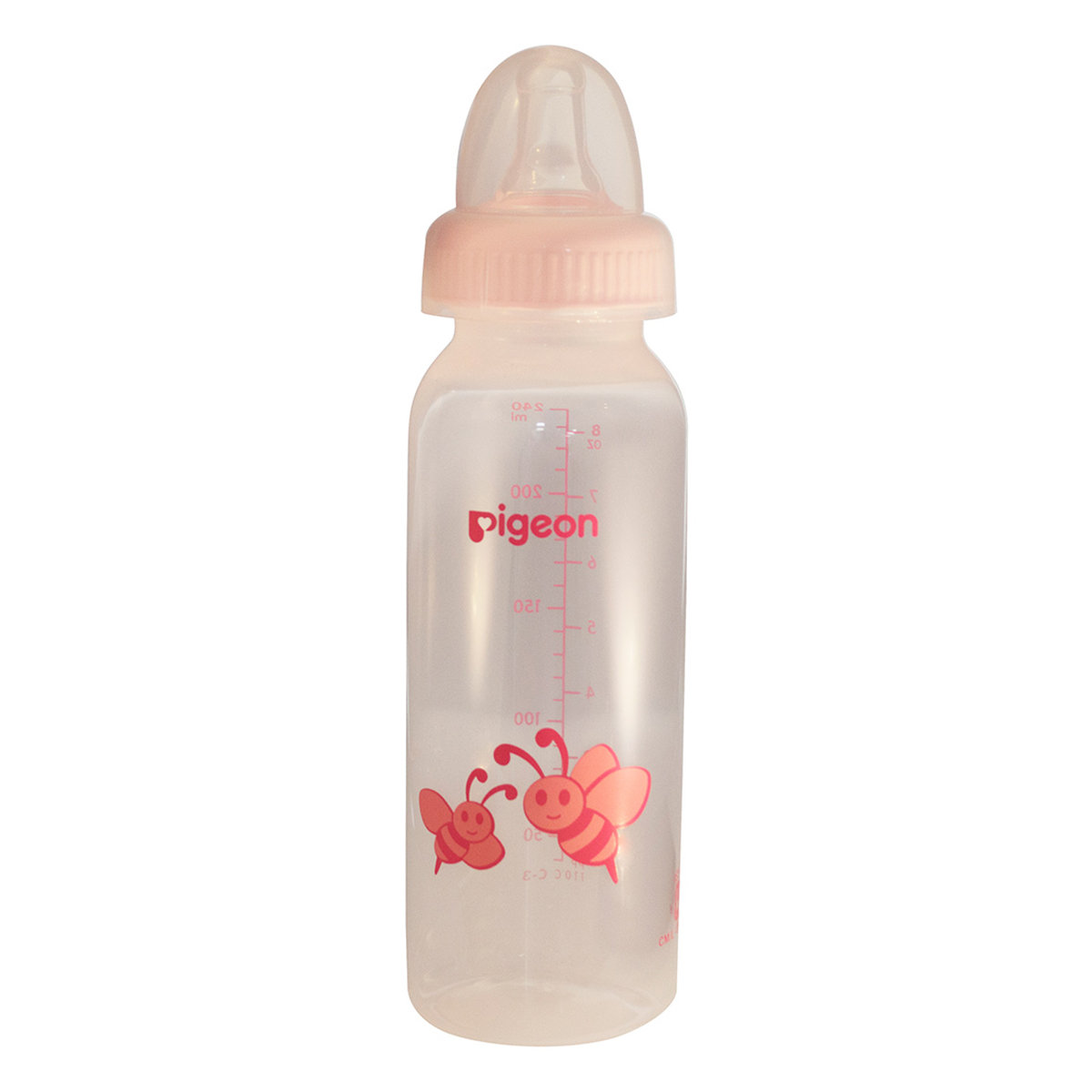
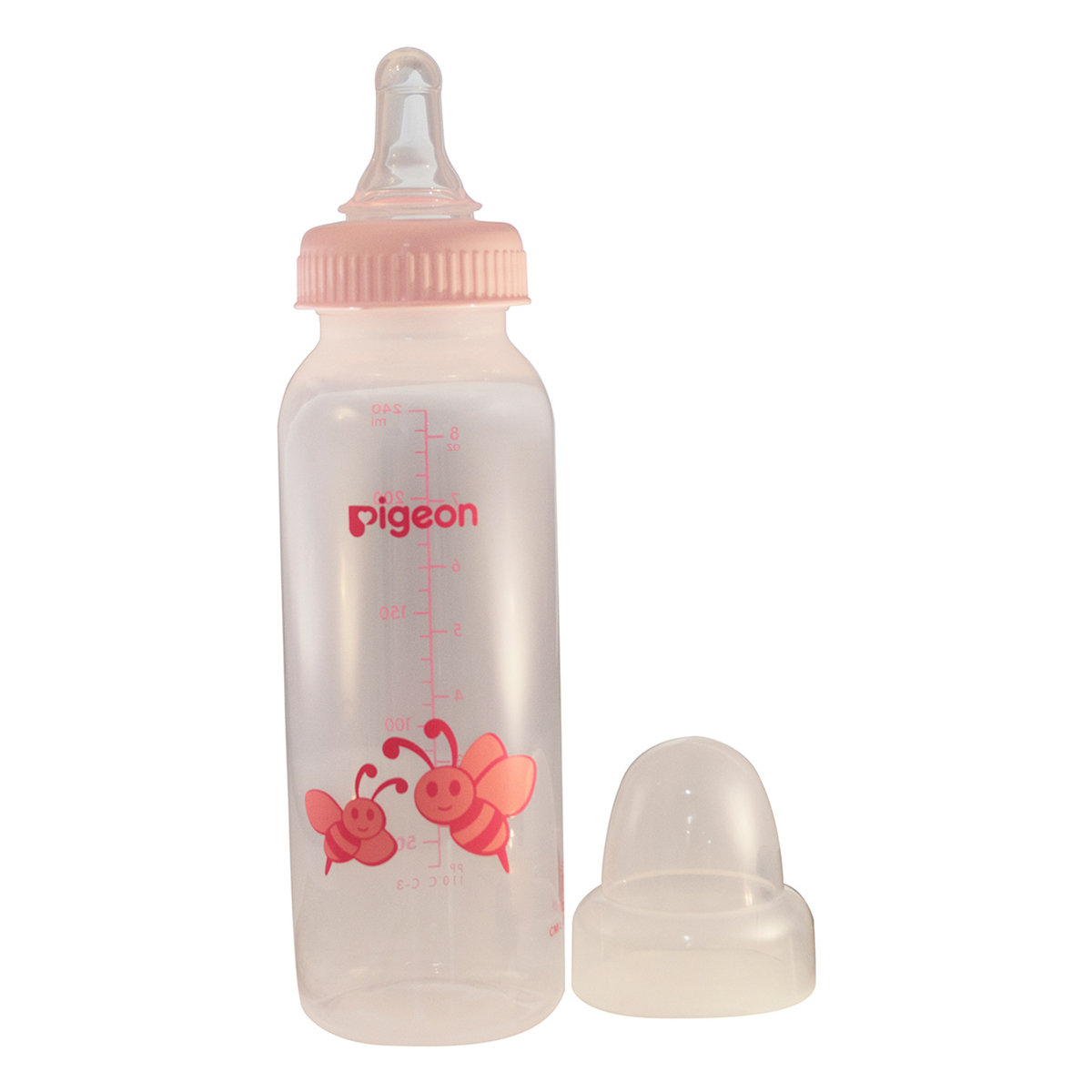
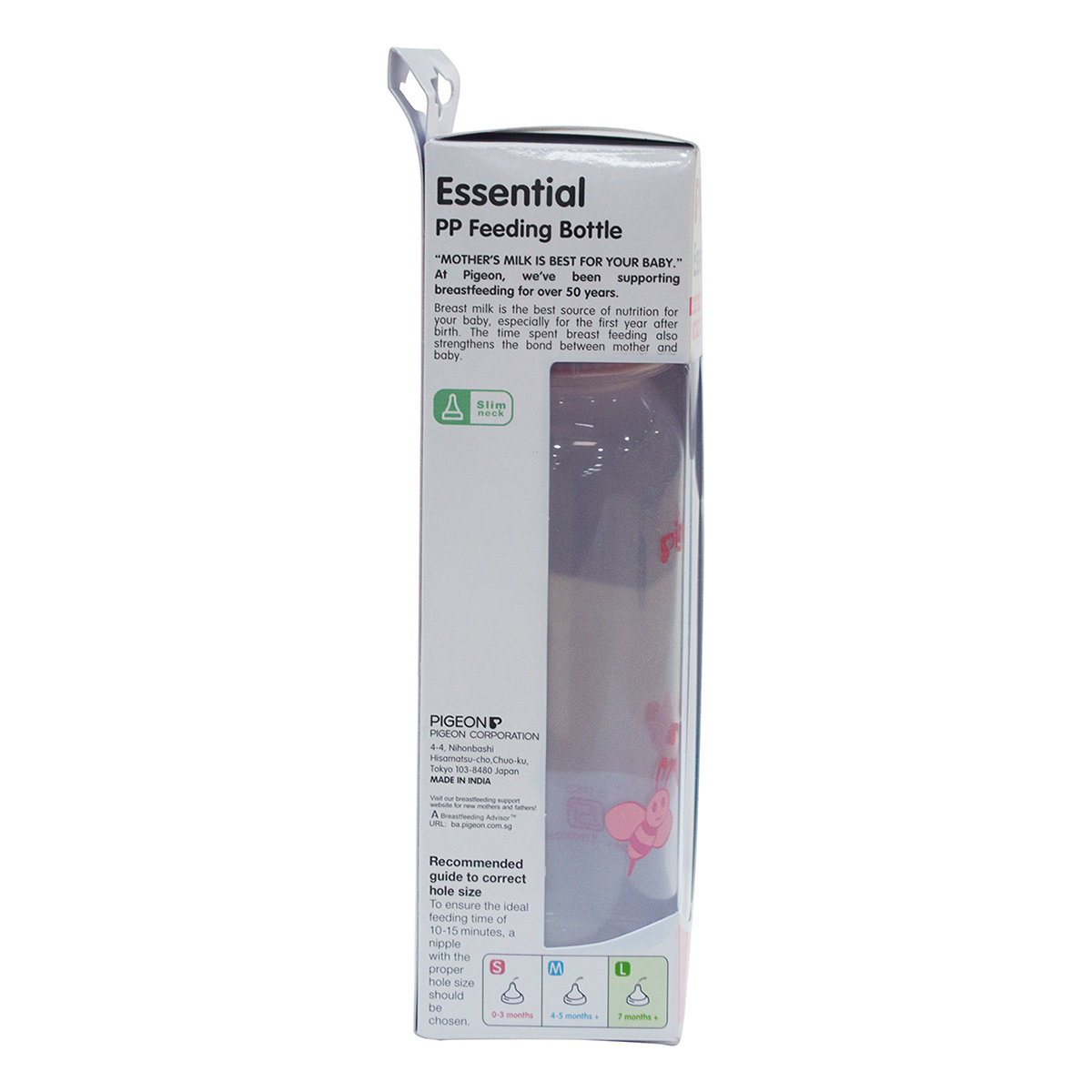
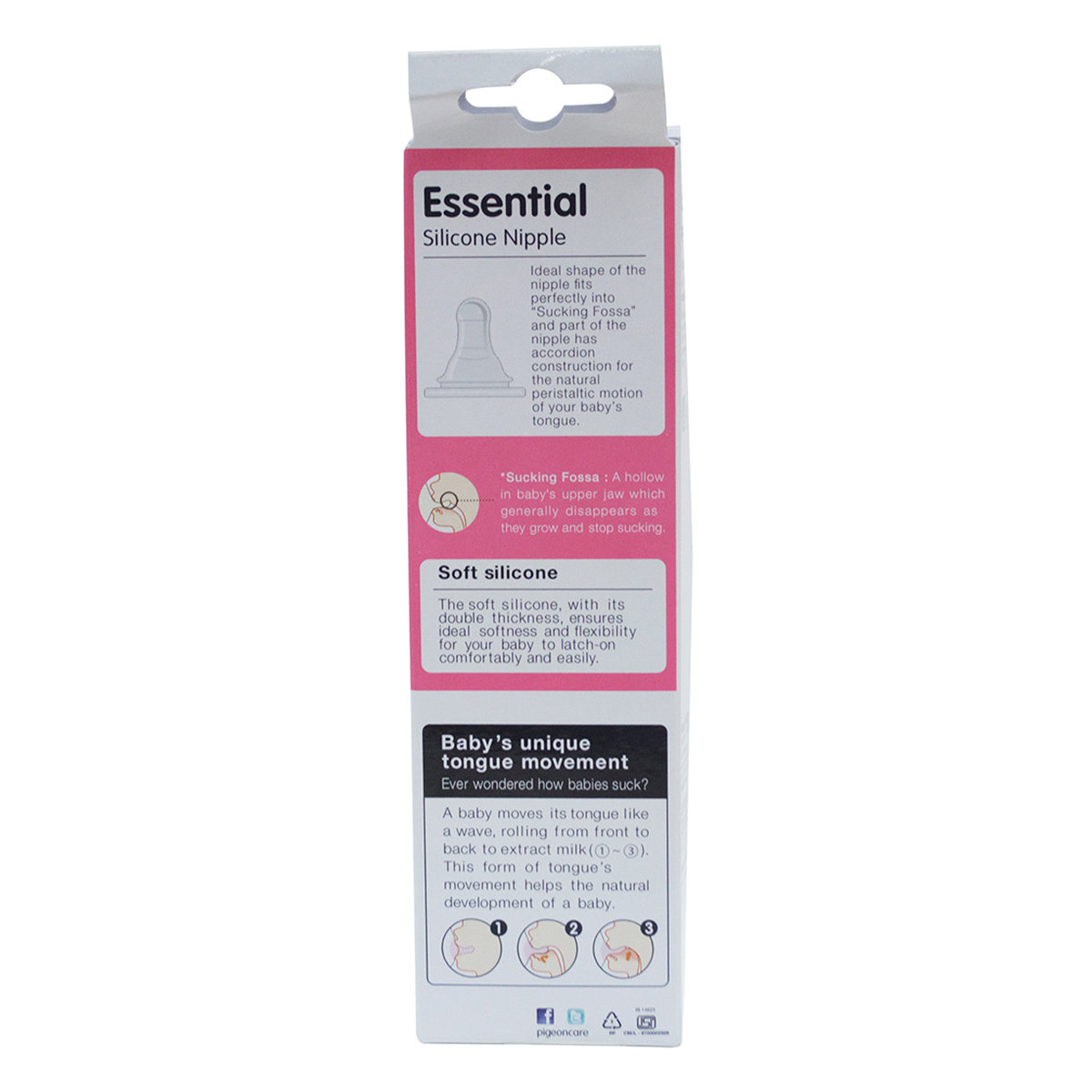
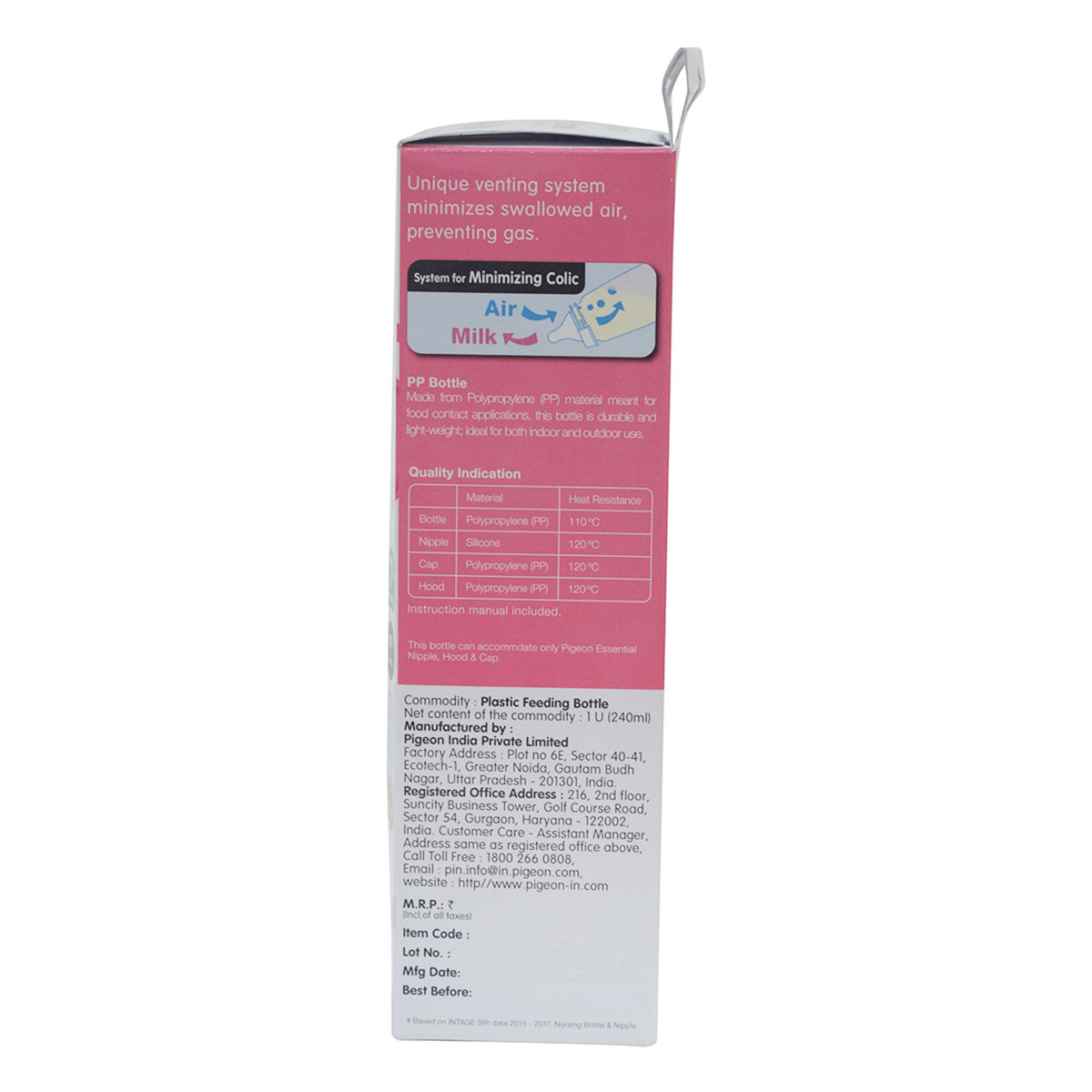
Selected Pack Size:240 ml
240 ml ₹141
(₹0.59 / 1 ml)
In Stock
120 ml ₹123.5
(₹1.03 / 1 ml)
In Stock
MRP ₹141
(Inclusive of all Taxes)
Get Free delivery (₹99)
Know Your Delivery Time
Provide Delivery Location

Secure Payment

India's Most Trusted Pharmacy

Genuine Products
Manufacturer/Marketer :
Consume Type :
Return Policy :
Expires on or after :
Description
The Pigeon Essential PP Feeding Bottle is designed for a natural feeding experience for your baby, aged 7 months and above. The pigeon feeding bottle has a soft silicone nipple, which emulates the three prime aspects of babies' sucking behaviour: attachment, peristaltic tongue movement, and swallowing, providing a breastfeeding-like experience. This bottle includes a venting system to control milk flow and keep air intake to a minimum, ensuring less gas and colic for your baby. The nipple shape fits just right into the 'Sucking Fossa,' with an accordion construction for your baby's natural peristaltic tongue motion. The bottle is made from food-grade polypropylene material, making it both durable and light-weight. In terms of pigeon bottle price, it provides great value given its thoughtful and practical features.
Features
- Soft silicone nipple with double thickness
- Unique venting system for air pressure management
- Slim neck design
- Made of durable, lightweight polypropylene material
Key Ingredients

Have a query?
Directions for Use
- Fill the bottle with the desired amount of heated milk or liquid baby food.
- Screw the teat and bottle top on securely, ensuring it's not too tight as this can prevent proper venting.
- Hold your baby in an upright position and guide them to latch onto the silicone nipple.
Key Benefits
- Natural Feeding Experience: The pigeon feeding bottle is engineered to provide a seamless transition from breastfeeding, with a soft silicone nipple that replicates the natural sucking motion. This allows your baby to attach, move their tongue peristaltically and swallow in a manner similar to breastfeeding.
- Digestive Comfort: The feeding bottle features a unique venting system that controls the milk flow and reduces air intake. This minimises the risk of gas and colic, providing a more comfortable feeding experience for your baby.
- Perfect Fit: The ideal shape of the nipple fits perfectly into your baby's 'Sucking Fossa.' Part of the nipple also has accordion construction, which supports the natural peristaltic motion of your baby's tongue.
- Lightweight Durability: Made from polypropylene material meant for food contact applications, this bottle is both sturdy and lightweight. It's suitable for both indoor and outdoor use, making it an ideal choice wherever you are feeding your baby.
- Soft Yet Resilient Nipple: The silicone rubber nipple on this bottle maintains an ideal balance between softness and elasticity thanks to its double thickness. This ensures a comfortable latch-on experience for your baby.
Safety Information
Always sterilise the bottle before use. Check the temperature of the milk or formula before feeding your baby. Never leave your baby unsupervised while feeding.
FAQs
Country of origin
Manufacturer/Marketer address
Customers Also Bought
Alternatives
Similar Products
Disclaimer
Buy best Baby Care products by
Others
CHICCO
PAMPERS
MAMYPOKO
PIGEON
Himalaya
JOHNSON & JOHNSON
APOLLO ESSENTIALS
APOLLO LIFE
HUGGIES
MAMAEARTH
APOLLO PHARMACY
Mother Sparsh
SEBAMED
PHILIPS AVENT
SIMILAC
LITTLE S
LACTODEX
MORISONS
CETAPHIL
NESTLE CERELAC
Dabur
SLURRP FARM
DEXOLAC
DENTOSHINE
LUVLAP
COLGATE
EQUALSTWO
APTAMIL
FLORITE
AVEENO
Areoveda
ORAL-B
Sanosan
MEE MEE
Bambo Nature
MOTHERCARE
PARACHUTE
FAREX
BONBABY
DOVE
IMF Gold
MMS
MUSTELA
NESTLE NAN PRO
PEDIFLOR
BIOTIQUE
FIXDERMA
NESTLE LACTOGEN
ALFAMIL
BUMBERRY
DERMADEW
TEDIBAR
BABY ORGANO
DAFFY
NESTLE NAN EXCELLAPRO
NIKOMOM
WEST COAST
AMUL
BABIO
BELLA
Braymil
Bumtum
FIGARO
Gerber
Kiddikind
LOVE MOMMA
MIMMO ORGANICS
PRISTINE
CEREGROW
JORDAN
KIDODENT
MEDELA
MINIMALIST
OILATUM
OLEMESSA
SANDU
Softens
TEDDYY
AQUAWHITE
B4 NAPPI
BENIBABY
Babyvita
ENFAMIL
MANNA
MEDOMIL
MUGLI
NESTLE NESTUM
NESTLE PRE NAN
Nestle
SOFIDEW
SUNNY S
VEELAC
VICKS
Vensi
Venusia
BONNE
CHEERIO
E-DEW
EASIFUD
Artsana India Pvt Ltd
Procter & Gamble Hygiene And Health Care Ltd
Pigeon India Pvt Ltd
Unicharm India Pvt Ltd
Nestle India Ltd
The Himalaya Drug Company
Johnson & Johnson Pvt Ltd
Nutricia International Pvt Ltd
KIMBERLY-CLARK INDIA PVT LTD
Apollo Healthco Limited
Honasa Consumer Pvt Ltd
APOLLO HEALTHCO LIMITED
USV Pvt Ltd
ABBOTT HEALTHCARE PVT LTD
Philips India Ltd
Raptakos Brett & Co Ltd
MOTHER SPARSH BABY CARE PVT LTD
Piramal Enterprises Ltd
J L Morison India Ltd
Dabur India Ltd
MOTHER AND BABYCARE INC.
Galderma India Pvt Ltd
Wholsum Foods Pvt Ltd
Evexia Healthcare Pvt Ltd
AVODEN PVT LTD
Universal Corporation Ltd
Torrent Pharmaceuticals Ltd
Colgate-Palmolive (India) Ltd
Zydus Lifesciences Ltd
IMPERIA HEALTHCARE PVT LTD
Flo-Rite Baby Product Pvt Ltd
NUTRIBRAY HEALTHCARE PVT LTD
Glowderma Lab Pvt Ltd
Jntl Consumer Health (India) Pvt Ltd
LIFECELL INTERNATIONAL PVT LTD
ALL THINGS BABY INDIA PVT LTD
Bebymil International Pvt Ltd
British Life Sciences Pvt Ltd
ME N MOMS PVT LTD
Marico Ltd
RELIANCE BRANDS LTD
BONNY PRODUCTS PVT. LTD.
Group Pharmaceuticals Ltd
Hindustan Unilever Ltd
Rama Vision Ltd
Bio Veda Action Research Company
Fixderma India Pvt Ltd
PANACEA BIOTEC LIMITED
Hegde & Hegde Pharmaceutica Llp
MEAD JOHNSON NUTRITION (INDIA) PVT. LTD.
Modi Mundipharma Pvt Ltd
Nutrimed Healthcare Pvt Ltd
Mankind Pharma Pvt Ltd
Natureovedic Consumers Pvt Ltd
Pristine Organics Pvt Ltd
TITUS HEALTH TECH
West Coast Pharmaceuticals Pvt Ltd
A. Menarini India Pvt Ltd
Adonis Laboratories Pvt Ltd
Bella Premier Happy Hygienecare Pvt Ltd
Carey Pharma
Deoleo India Pvt Ltd
Dr Reddy's Laboratories Ltd
FAMILYCARE CONSUMER PVT. LTD
GUJARAT CO-OPERATIVE MILK MARKETING FEDERATION LTD
KHINAYSHA INTERNATIONAL
Klm Laboratories Pvt Ltd
MIMMO ORGANICS PVT LTD
Novel Tissues P Ltd
OPTRA PHARMACEUTICALS
A-Orkla India Pvt Ltd
Medela India Pvt Ltd
NEONESH HEALTHCARE PVT LTD
National Chemical & Pharmaceutical Works (P) Ltd
Nobel Hygiene Pvt Ltd
SOFTSENS CONSUMER PRODUCTS PVT LTD
Sandu Pharmaceuticals Pvt Ltd
Stiefel India Pvt Ltd
Uprising Science Pvt Ltd
WENOVA BRANDS PVT LTD
XTRACARE HYGIENE PVT. LTD.
Abbott India Ltd
Arlac Biotech Pvt Ltd
FDC Ltd
JHS SVENDGAARD BRANDS LTD
Leeford Health Care Ltd
Leeford Healthcare Ltd
Rely On Pharmaceuticals
SHRI RAM AYURVED BHAWAN
SUNNY DRUG & PHARMA PVT LTD
Southern Health Foods Pvt Ltd
TTK Healthcare Ltd
Warren Remedies Pvt Ltd
Wipro Consumer Care
BABYWIN BABY PRODUCTS
Ban Labs Pvt Ltd
Budds Buddy
DWIBHASHI BAPANNA AYURVEDA NILAYAM PVT LTD
ENTREMONDE POLYCOATERS LTD.
Glenmark Pharmaceuticals Ltd
DIAPER - PANT STYLE
FEEDING BOTTLE
IMF STAGE-1
BABY SOAP
BABY LOTION
BABY MASSAGE OIL
BABY CREAM
BABY WIPE
BABY WASH
IMF STAGE-2
BABY TOOTHPASTE
BABY TOOTHBRUSH
BABY CEREALS 6+
BABY SHAMPOO
BOTTLE NIPPLE
BABY POWDER
IMF SPECALITY
DIAPER RASH CREAM
BABY GIFT SET
IMF STAGE-3
TAPED DIAPERS
BABY DIGESTION
BABY MATT
BREAST PUMP
TODDLER FOOD
BABY CEREAL
BABY SUNSCREEN
BABY CEREALS 8+
BABY MOSQUITO REPELLENT
MEDICAL NEEDS
BABY HAIR OIL
IMF
Nursing Pad
Soother
BABY COTTON BUD
BABY DROPS
Tooth Brush
BABY CEREALS 10+
Nipple Shield
Teether
BOTTLE WASHING LIQUID
IMF STAGE-4
LAUNDRY DETERGENT
BABY CEREALS 12+
BABY ROLL ON
NAPPY PAD
TODDLER DRINK
BABY GROOMING
BOTTLE BRUSH
BREAKFAST CEREAL
Massage Oil
TODDLER SNACK
Body Wash
Tooth Paste
Toys
Ayurvedic Syrup
BABY ACCESSORIES
BABY CEREALS 18+
BABY RUB
Pacifier
Soap
Sterilizer
BABY LIP BALM
BODY CREAM
Baby Nose Cleaner
Baby Powder puff
Disinfectant Liquid
Food Storage Set
GUM CLEANER
Kids Nutrition Drink
Moisturiser
Sterilizing Bags
Sun Screen
BABY BIB
BOTTLE WARMER
Biochemic
Body Butter
Body Lotion
Breast Cream
COOKING OIL
COUGH SYRUP
Dusting Powder
FACIAL WIPE
Hair Oil
Hand Wash
Humidifier
NASAL ASPIRATOR
Nipple Puller
POTTY SEAT
Tongue Cleaner



